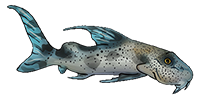| Scientific Name | Ageneiosus magoi Castillo & Brull G., 1989 |
| Common Names | Unicorn Catfish Duck Catfish, Slopehead Catfish, Stiplet Andemalle (Denmark) |
| Type Locality | Los esteros de Camaguán at kilometer 270, Estado Guárico, Venezuela. |
| Pronunciation | ah genie OH sus - mah go eye |
| Etymology | Ageneiosus, from the Greek a, meaning without and genias, meaning beard in reference to the apparent lack of barbels. In fact, catfish of this genus have very short maxillary barbels that are almost indistinguishable to the human eye. The species is named in honor of Francisco Mago-Leccia (1931-2004), for his contributions to the study and knowledge of Venezuelan fishes, and his valuable work forming a new generation of ichthyologists. |
| Articles | |
| Size | 181mm or 7.1" SL. Find near, nearer or same sized spp. |
| Identification | Ageneiosus differs from other Auchenipteridae, except Tympanopleura, by having: 1, long bony process, narrowing distally on anterolateral border of sphenoid; 2, longitudinal groove on posterior margin of anterior fontanel (also present in Pseudepapterus); 3, dorsal portion of posttemporal-supracleithrum divided into two prominent branches; 4, internal and external processes of epioccipital sutured to parapophyses of fifth and sixth vertebrae; 5, bony process on posteromedial border of first infraorbital bone (also present in Tetranematichthys); 6, anterior or posterior region of second infra-orbital very curved; 7, bony expansion on laterodorsal margin of premaxilla; 8, operculum with spongy ossification; 9, bone projections on posterior extreme of the parurohyal; 10, seventh vertebra not fused to complex vertebrae (also present in Pseudepapterus); 11, well-developed crown of spines in proximal region of anterior margin of dorsal-fin spine of mature males; 12, short maxillary barbel, not extending posteriorly beyond snout (also present in Tetranematichthys); 13, mental barbels absent; 14, bony spines on maxillary barbel of mature males; 15, posterior lobes of testes reduced or absent (also present in Auchenipterus). Ageneiosus differs from Tympanopleura by having: 1, reduced and completely ossified gas bladder in adults, except Ageneiosus pardalis Lütken 1874 (v. large, non-ossified gas bladder during all phases of ontogenetic development); 2, posterior diverticula on the gas bladder absent (v. having paired posterior diverticula on the gas bladder, except T. piperata); 3, epaxial muscles almost completely covering the tympanic region in adults, except A. pardalis (v. tympanic region translucent, not covered by epaxial muscles); 4, dorsal process on the base of pectoral fin weakly developed, loosely articulating with cleithrum (v. dorsal process on the base of pectoral fin well developed, strongly articulating with cleithrum); 5, fenestra on the lateral wall of cleithrum (v. lateral wall of cleithrum completely ossified).
A key to the species of Ageneiosus is located here. Easily recognized by the black and white pattern, although the pattern itself can differ a lot. |
| Sexing | Like all Auchenipterids, males have a genital papilla. Moreover, sexually active males get an enlarged and slightly curved dorsal spine and thickened barbels, that are used to clasp the female. After the breeding season, the dorsal spine and the barbels grow back to their normal sizes. |
| General Remarks | Wild caught specimen show some yellow on their body and fins, which disappears after some time in an aquarium. In contradiction to most other Auchenipterids, this species may be very active during the day. |
| Distribution | South America: Orinoco basin. Orinoco (click on these areas to find other species found there) Login to view the map. |
| IUCN Red List Category | Least Concern , range map and more is available on the IUCN species page. Last assessed 2020. |
| pH | 6.4 - 7.0 |
| Temperature | 23.0-30.0°C or 73.4-86°F (Show species within this range) |
| Feeding | Voracious feeder that will eat anything that fits its mouth. Live fish, large frozen foods and pellets. When feeding live fish choose a proper source. It's best to breed them oneself. Feeding just goldfish is not recommended, as the quality of captive bred goldfish can be poor - which may cause diseases - and it's a very one sided diet. User data. |
| Furniture | Some pieces of driftwood as hiding spots. This species loves to swim against the current, so a large pump is obligatory. Provide lots of swimming space. |
| Compatibility | Will ignore fish that it can't swallow. |
| Suggested Tankmates | Larger catfishes like other Auchenipteridae, Doradidae and Loricariidae. Non-aggressive Characins like Metynnis. |
| Breeding | Unreported in the aquarium. |
| Breeding Reports | There is no breeding report. |
| Reference | Acta Biologica Venezuelica v. 12 (no. 3-4), pp 73, Figs. 1-3, 5-9. |
| Registered Keepers | There are 6 registered keepers, view all "my cats" data. |
| Wishlists | Love this species? Click the heart to add it to your wish list. There are 2 wishes to keep this species, see who wants what. |
| Spotters | Spotted this species somewhere? Click the binoculars! There are 12 records of this fish being seen, view them all. |
| Forum BBCode | |
| Search for A. magoi | |
| Look up A. magoi on AquaticRepublic.com | |
 | Look up A. magoi on Fishbase |
 | Look up A. magoi on Encyclopedia of Life |
 | Look up A. magoi on Global Biodiversity Information Facility |
| LFS label creator ARN ref:1.22.105.298 | |
| Last Update | 2025 Jan 02 01:38 (species record created: 2005 Jun 29 00:00) |





/siluriformes/auchenipteridae/ageneiosus/magoi/1.jpg)
/siluriformes/auchenipteridae/ageneiosus/magoi/2.jpg)
/siluriformes/auchenipteridae/ageneiosus/magoi/3.jpg)
/siluriformes/auchenipteridae/ageneiosus/magoi/4.jpg)
/siluriformes/auchenipteridae/ageneiosus/magoi/5.jpg)
/siluriformes/auchenipteridae/ageneiosus/magoi/6.jpg)
/siluriformes/auchenipteridae/ageneiosus/magoi/7.jpg)
/siluriformes/auchenipteridae/ageneiosus/magoi/8.jpg)
/siluriformes/auchenipteridae/ageneiosus/magoi/9.jpg)
/siluriformes/auchenipteridae/ageneiosus/magoi/10.jpg)
/siluriformes/auchenipteridae/ageneiosus/magoi/11.jpg)
/siluriformes/auchenipteridae/ageneiosus/magoi/12.jpg)